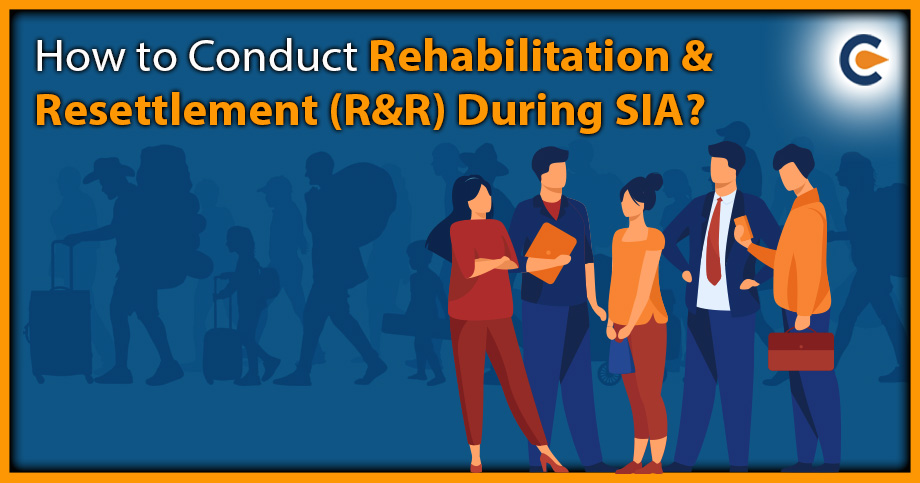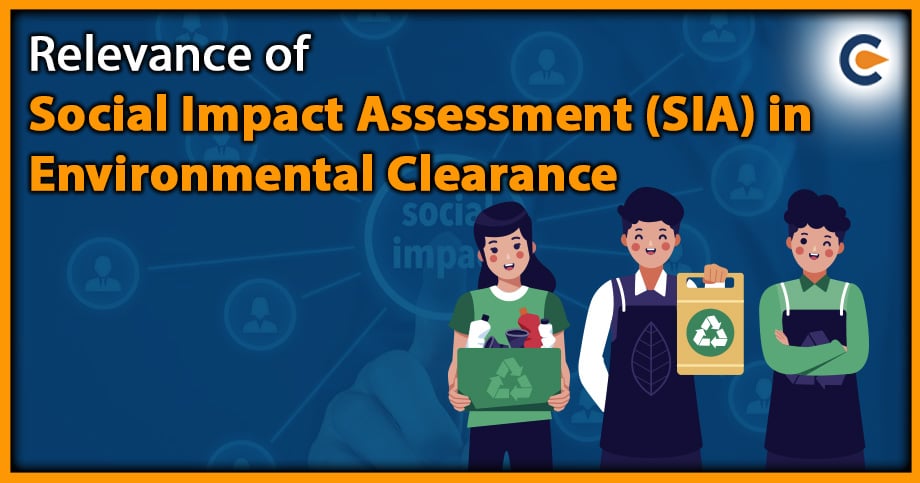Development projects are important in many ways. Although they may create a significant change in the lives of locals, including the acquisition of their land, loss of livelihood and other issues that may not be rightly compensated, it also provides a lot of opportunities in terms of new jobs, improved sense of well-being and increase in prices of nearby property. R&R during SIA forms a part of the EIA and EMP and is assessed and approved by the Expert Appraisal Committee or EAC under MoEF&CC for according Environmental Clearance to the proposed project. Resettlement and rehabilitation are needed in case of land acquisition for a public or private project that displaces local residents, tenants, shops and other business establishments and causes loss of property and livelihoods.
Land Acquisition is the process through which the government can acquire private land. This may include any other private property. It is done for the purpose of public work such as building infrastructure, urbanisation projects, development and industrialisation activities. Government can acquire land for private companies or firms to aid them in setting up factories or other industrial setups. Although the purchase of land is an agreement between buyer and seller, where both parties are willing to enter into a contract, in the case of land Acquisition, the land owner has no choice. This is the reason right to property is a legal right, not a fundamental right.
What Is An R&R During SIA?
The R&R Plan is prepared for the affected families or individuals that will be affected in the course of the project’s implementation. The plan focuses on baseline surveys, resettlement, socio-economic surveys, census surveys and social impact assessments. Analysis of regional and national data and development of frameworks for community participation and preparation of resettlement action plans for mitigating the negative impacts of development projects on the affected communities.
For any new and upcoming projects, the compensation awarded for R&R must be according to the RFCTLARR Act, 2013[1]. The R&R during SIA is implemented in association with the State Governments concerned, representatives from project-affected families and other stakeholders in the project area.
Stages in Rehabilitation and Resettlement Planning
If the government is of the opinion that large displacement will be caused, it will declare the area as an affected area under paragraph 6.1 of the R&R policy, 2007. An Administrator for R&R during SIA will undertake the baseline survey and a recent census to identify the persons and families likely to be affected.
Analysis of Alternatives of Land Acquisition: The anticipated loss due to the project can be broadly categorised into loss of land assets and loss of non-land assets (built-up properties). The aim should be to minimise any large-scale displacement. Apart from it, only the minimum area of land that commensurate with the purpose of the project should be acquired.
It is advised that the project should be set up on wasteland, degraded land or un-irrigated land wherever possible. Acquisition of agricultural land for non-agricultural use in the project may be kept to the minimum; multi-cropped land may be avoided to the extent possible for such ‘purposes, and acquisition of irrigated land, if unavoidable, may be kept to the minimum.
Minimisation of Social Impacts: in case large numbers of families are affected as a part of R&R during SIA, social impact assessments have to be conducted to provide all required infrastructural facilities and amenities in the resettlement area. More particularly, where the Scheduled Tribes people are being displaced in sizeable numbers, a well-thought-out Tribal Development Plan must be put in place.
Rehabilitation and Resettlement Issues: A detailed socio-economic survey is conducted before formulating the R&R Plan for the project-affected families (PAFs) to assess the socio-economic and socio-cultural setup of the affected families and local people.
The Act proposes for R&R during the SIA study is to map and estimate costs and benefits to the people affected through the acquisition by addressing the concerns of farmers and those whose livelihoods depend on the land being acquired while at the same time facilitating land acquisition for infrastructure project and industrialisation in a timely and transparent manner.
Community Consultation and Participation: In cases where both EIA and SIA are required, the public hearing done in the project-affected area for EIA shall also cover issues related to R&R during SIA. Such public hearings shall be organised by the appropriate government.
Mitigation Methods: In case of land being acquired, providing an alternative land of equivalent productive potential is subject to availability, preferably within the same village/ panchayat or cash compensation in case the families opt for it.
Monitoring & Evaluation: to ensure that the affected families receive the Rehabilitation assistance (RA), Monitoring & evaluation of the R&R during SIA is also needed. The overall control of the formulation and execution of the rehabilitation and resettlement plan is vested in the Administrator for Rehabilitation and Resettlement.
Focus areas of R&R during SIA Process.
During the planning, the following stages must be considered
Impact Categories used in R&R
- Loss of Land (agricultural, homestead, commercial or otherwise)
- Loss of Structure (house, shop, building or immovable property or assets attached to the land)
- Loss of Residence
- Loss of shop /trade /commercial structure
Basic Amenities and Infrastructural Facilities in Settlement Site
Planning and development of R&R site for housing and other civic amenities such as approach road, drainage, water, electricity, sanitation etc., construction of community hall, sanitation and sewerage, religious worship house, post office, panchayat ghar, school, fair price shop, market, playground, veterinary services, free treatment and medicines to the oustees in the project
| For project-affected persons | For village infrastructure |
| Construction of residential houses. | Development of grazing land |
| Construction of sanitary latrine | Site development for village land |
| Construction of granary | Development of roads, Providing power and water supply, construction of sanitation and sewerage facilities etc. |
| Construction/grant of/for cattle /poultry sheds. | Construction of school building, religious worship place, construction of Community Hall, Construction of Panchayat Ghar, Construction of post office building, Grant for opening fair price shop |
| Agricultural /horticultural land | Medical facilities- primary health centre, Veterinary services |
| Land development and protection measures against sediment flow | Construction of market, park and playground |
| Transportation/displacement grant | Preservation of historical monuments and biodiversity sites. |
Economic Rehabilitation as a Part of R&R during SIA
It is usually in the form of grants for Agricultural and Horticultural activities like Dairying, Poultry rearing, other farm animals or any other non-farm economic activities.
The administrator responsible for R&R on behalf of the government may either purchase land from any person through consent award and enter into an agreement or approach the State Government for the acquisition of land for the purposes of R&R during SIA while ensuring that the acquisition of land does not lead to another displaced families.
In many cases, training on cultivation and management of soil and water conservation in hills and hill slopes, in terraced lands, selection of crops and varieties as well as other cultural practices for better production, management and upkeep of livestock, weaving and designing, handicrafts etc. is also given.
Public Hearing Requirements in R&R during SIA
The SPCB ensure that a public hearing is held in the affected area after giving adequate publicity about the date, time and venue to ascertain the views of the affected families during public hearing. It must be recorded and included in the SIA Report.
Appraisal of SIA
SIA Report to be evaluated by an independent multidisciplinary Expert Group consisting of two non-official social scientists, two representatives of Panchayat, Gram Sabha, Municipality or Municipal Corporation, two experts on rehabilitation and A technical expert in the subject relating to the project
Advantages of Conducting Detailed R&R during SIA
- Identifying Affected Groups
- Free and Fair information sharing
- Avoiding Adverse Impacts
- Enhancing Positive Impacts
- Reducing Costs
- Study areas in the Preliminary SIA study
Conclusion
A Rehabilitation and Resettlement Policy must be developed as a part of the SIA study based on the changes that will be introduced by the proposed project in the future. The extent of land acquired and the structures to be lost by the project is an indicator of impact on the social environment. Based on the impact on the properties of the locals and the land required, the consultations, engineering, environmental and social team constructs the R&R plan and propose to reduce and minimise the impact on those displaced. Therefore, the plight of those who have sacrificed their resources for the larger benefit of society should be given due importance as a part of the responsibility of the developers. The assistance of environmental consultants in R&R during SIA can help the proponent device means to implement and protect the rights of the affected, build a positive reputation in the eyes of the general public, and reflect on their approach towards sustainable development.
Read Our Article: How To Conduct SIA In India: An Overview











